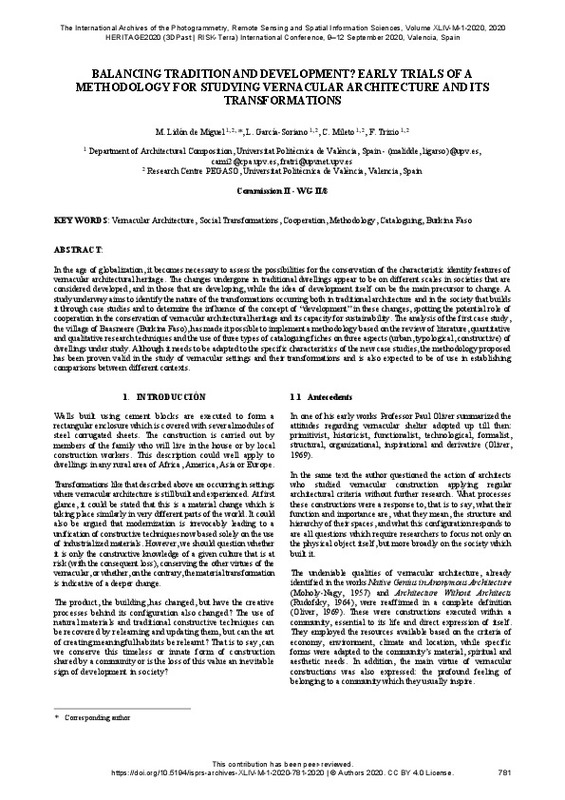Lidón De-Miguel, M.; García-Soriano, L.; Mileto, C.; Trizio, F. (2020). Balancing Tradition and Development? Early Trials of a Methodology for Studying Vernacular Architecture and its Transformations. International Archives of the Photogrammetry, Remote Sensing and Spatial Information Sciences (Online). 44:781-788. https://doi.org/10.5194/isprs-archives-XLIV-M-1-2020-781-2020
Por favor, use este identificador para citar o enlazar este ítem: http://hdl.handle.net/10251/169138
|
Título:
|
Balancing Tradition and Development? Early Trials of a Methodology for Studying Vernacular Architecture and its Transformations
|
|
Autor:
|
 Lidón de-Miguel, María
Lidón de-Miguel, María

 García-Soriano, Lidia
García-Soriano, Lidia

 Mileto, Camilla
Mileto, Camilla

 Trizio, Francesca
Trizio, Francesca
|
|
Entidad UPV:
|
Universitat Politècnica de València. Departamento de Composición Arquitectónica - Departament de Composició Arquitectònica
|
|
Fecha difusión:
|
|
|
Resumen:
|
[EN] In the age of globalization, it becomes necessary to assess the possibilities for the conservation of the characteristic identity features of vernacular architectural heritage. The changes undergone in traditional ...[+]
[EN] In the age of globalization, it becomes necessary to assess the possibilities for the conservation of the characteristic identity features of vernacular architectural heritage. The changes undergone in traditional dwellings appear to be on different scales in societies that are considered developed, and in those that are developing, while the idea of development itself can be the main precursor to change. A study underway aims to identify the nature of the transformations occurring both in traditional architecture and in the society that builds it through case studies and to determine the influence of the concept of ¿development¿ in these changes, spotting the potential role of cooperation in the conservation of vernacular architectural heritage and its capacity for sustainability. The analysis of the first case study, the village of Baasneere (Burkina Faso), has made it possible to implement a methodology based on the review of literature, quantitative and qualitative research techniques and the use of three types of cataloguing fiches on three aspects (urban, typological, constructive) of dwellings under study. Although it needs to be adapted to the specific characteristics of the new case studies, the methodology proposed has been proven valid in the study of vernacular settings and their transformations and is also expected to be of use in establishing comparisons between different contexts.
[-]
|
|
Palabras clave:
|
Vernacular architecture
,
Social transformations
,
Cooperation
,
Methodology
,
Cataloguing
,
Burkina Faso
|
|
Derechos de uso:
|
Reconocimiento (by)
|
|
Fuente:
|
International Archives of the Photogrammetry, Remote Sensing and Spatial Information Sciences (Online). (eissn:
2194-9034
)
|
|
DOI:
|
10.5194/isprs-archives-XLIV-M-1-2020-781-2020
|
|
Editorial:
|
Copernicus Publ.
|
|
Versión del editor:
|
https://doi.org/10.5194/isprs-archives-XLIV-M-1-2020-781-2020
|
|
Título del congreso:
|
HERITAGE2020 (3DPast | RISK-Terra), International Conference on Vernacular Architecture in World Heritage Sites. Risks and New Technologies
|
|
Lugar del congreso:
|
Valencia, España
|
|
Fecha congreso:
|
Septiembre 09-12,2020
|
|
Código del Proyecto:
|
info:eu-repo/grantAgreement/MECD//FPU17%2F02428/
|
|
Agradecimientos:
|
This research was funded by a grant from the Centre for
Development Cooperation of Universitat Politècnica de
València, which financed a visit for data-collection to Baasneere.
This grant aims to encourage cooperation ...[+]
This research was funded by a grant from the Centre for
Development Cooperation of Universitat Politècnica de
València, which financed a visit for data-collection to Baasneere.
This grant aims to encourage cooperation between the university
and associations and NGOs working in international cooperation.
In this case, during this visit, the authors collaborated with the
project that the NGO Algemesí Solidari is carrying out in the
village of Baasneere with its counterpart, A3B.
The authors wish to thank the members of these two associations
for their collaboration in the development of the research. They
would also like to thank the inhabitants of Baasneere particularly
for their welcome and assistance, and particularly Ouedraogo
Ismaël, guide and interpreter during the visit.
The initial stages of this research were part of the ConBurkina
research project, also funded by the UPV Centre for
Development Cooperation, again to support and collaborate with
the NGO Algemesí Solidari. Furthermore, the study presented is
part of the research carried out for a doctoral thesis funded by an
FPU grant from the Spanish Ministry of Education, Culture and
Sport.
[-]
|
|
Tipo:
|
Artículo
Comunicación en congreso
|









